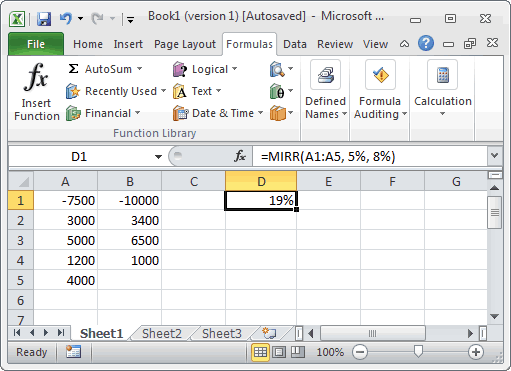Description
The Microsoft Excel MIRR function returns the modified internal rate of return for a series of cash flows. The internal rate of return is calculated by using both the cost of the investment and the interest received by reinvesting the cash.
The cash flows must occur at regular intervals, but do not have to be the same amounts for each interval.
Syntax
The syntax for the MIRR function in Microsoft Excel is:
MIRR( range, finance_rate, reinvestment_rate )
Parameters or Arguments
- range
- A range of cells that represent the series of cash flows.
- finance_rate
- The interest rate that you pay on the cash flow amounts.
- reinvestment_rate
- The interest rate that you receive on the cash flow amounts as they are reinvested.
Applies To
- Excel 2016, Excel 2013, Excel 2011 for Mac, Excel 2010, Excel 2007, Excel 2003, Excel XP, Excel 2000
Type of Function
- Worksheet function (WS)
- VBA function (VBA)
Example (as Worksheet Function)
Let's look at some Excel MIRR function examples and explore how to use the MIRR function as a worksheet function in Microsoft Excel:

Based on the Excel spreadsheet above:
This first example returns a modified internal rate of return of 19%. It assumes that you start a business at a cost of $7,500 - this amount was borrowed at a rate of 5%. You net the following income for the first four years: $3,000, $5,000, $1,200, and $4,000. The net income was reinvested at a rate of 8%.
=MIRR(A1:A5, 5%, 8%)
Result: 19%
This next example returns a modified internal rate of return of 7%. It assumes that you start a business at a cost of $10,000 - this amount was borrowed at a rate of 6.5%. You net the following income for the first three years: $3,400, $6,500, and $1,000. The net income was reinvested at a rate of 10%.
=MIRR(B1:B4, 6.5%, 10%)
Result: 7%
Example (as VBA Function)
The MIRR function can also be used in VBA code in Microsoft Excel.
For example:
Dim LNumber As Double
Static Values(5) As Double
Values(0) = -7500
Values(1) = 3000
Values(2) = 5000
Values(3) = 1200
Values(4) = 4000
LNumber = Mirr(Values(), 0.05, 0.08)
In this example, the variable called LNumber would now contain the value of 0.16506818.
No comments:
Post a Comment